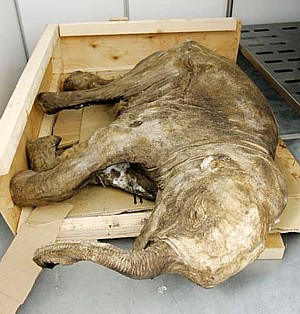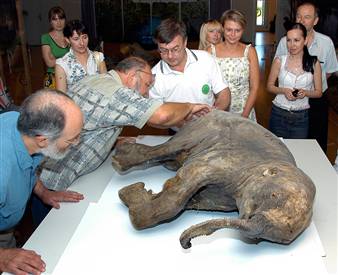
March 16, 2008

This is not the Oimyakon mammoth, but a better preserved specimen being studied in 2007. It was found by hunter Yuri Khudi in Russia’s Arctic Yamalo-Nenetsk region, in May 2007.
On September 27, 2004, the front part of a baby mammoth’s body was found in Olchan mine in the Oimyakon Region of Yakutia. Specialists of the Museum of Mammoth of the Institute of Applied Ecology of the North, Academy of Sciences of Sakha Republic (Yakutia), have been thoroughly studying the finding and they have published the first outcomes.

Not the Oimayakon specimen; a group of scientists examines the 2007 Yamalo-Neneetsk find.
There remained only the head, part of the proboscis, the neck area and part of the breast of the baby mammoth’s body. The body is practically cut off behind the withers and shoulder area. The skin on the head is torn on the forehead and cinciput, the skull is damaged, the proboscis is torn off. The baby mammoth’s skin is well preserved, it is smooth, greyish-brown, the tawny hair fell out and froze into the ice near the body. Under the skin, there remained muscles and the alveole with a permanent 76 millimeter long tusk, which had come through. Since the replacement of milk-tusks by permanent ones happened with mammoths at the age of one year the earliest, the researchers decided that the baby they had found perished approximately at this age. As the tusk is short, it can be assumed that the Oimyakon mammoth was a female (male’s tusks are longer).
The animal’s remains were investigated by the X-ray computer-aided tomography methods at the National Centre of Medicine in Yakutsk. Roentgenograms allowed to determine the baby’s age more accurately: judging by the teeth state, the mammoth was at least one year old but no more than a year and a half. The baby mammoth was already able to feed on vegetation independently. There are adipose deposits along the
neck and practically from the skull foundation through to the withers area, the adipose deposits are up to seven centimetres thick. These deposits form real adipose “pockets” and they get over to the body sides.

The Stone Age artists often used to draw mammoths with a big hump on the back. Some specialists assume that mammoths laid adipose tissue on the withers like zebu or camels do, others believe that the hump on the back could be the consequence of vigorous muscles development, the third group thinks that mammoths’ “gibbosity” in the drawings of ancient human beings reflects the large mane development. In the
Yakutsk researchers’ opinion, the adipose tissue discovered by them on the baby mammoth’s withers is the evidence that mammoths used to accumulate significant adipose deposits particularly in this part of the body. Such deposits helped them to survive the most severe conditions and water shortage during snowless winters.
Judging by radiocarbon dating performed at the University of Groningen (Netherlands), the little mammoth perished during the Kargin interglacial period, 413000±900 years ago. The sediments that contained the mammoth’s dead body preserved pollen, which mainly belonged to herbaceous and shrubby plants. The little mammoth lived among sedge and motley grass swamps. Now, these places are covered by larch woodland
with a touch of alder-trees.
Specialists have checked the Oimyakon mammoth for presence of particularly dangerous infections, but found nothing. The baby did not die from an infectious disease. Apparently, it got stuck and drowned in a waterlogged place. Complete hair shedding and skin exfoliation on some parts of the body testify to the fact that the mammoth’s body stayed in water for a long time. Most probably, the little mammoth
drowned in autumn, because its body froze into the ice soon and then it was covered by mudslide, thanks to which the body remained in the frozen state.
At present, the baby mammoth is still frozen. The researchers are sure that integrated study of this object will provide the scientific community with a lot of new data about the height, development, molecular and genetic peculiarities of the mammoths, as well as multiple data on paleo-ecology of the late Pleistocene.
About Loren Coleman
Loren Coleman is one of the world’s leading cryptozoologists, some say “the” leading living cryptozoologist. Certainly, he is acknowledged as the current living American researcher and writer who has most popularized cryptozoology in the late 20th and early 21st centuries.
Starting his fieldwork and investigations in 1960, after traveling and trekking extensively in pursuit of cryptozoological mysteries, Coleman began writing to share his experiences in 1969. An honorary member of Ivan T. Sanderson’s Society for the Investigation of the Unexplained in the 1970s, Coleman has been bestowed with similar honorary memberships of the North Idaho College Cryptozoology Club in 1983, and in subsequent years, that of the British Columbia Scientific Cryptozoology Club, CryptoSafari International, and other international organizations. He was also a Life Member and Benefactor of the International Society of Cryptozoology (now-defunct).
Loren Coleman’s daily blog, as a member of the Cryptomundo Team, served as an ongoing avenue of communication for the ever-growing body of cryptozoo news from 2005 through 2013. He returned as an infrequent contributor beginning Halloween week of 2015.
Coleman is the founder in 2003, and current director of the International Cryptozoology Museum in Portland, Maine.
Filed under Breaking News, Cryptotourism, CryptoZoo News, Cryptozoologists, Cryptozoology, Fossil Finds